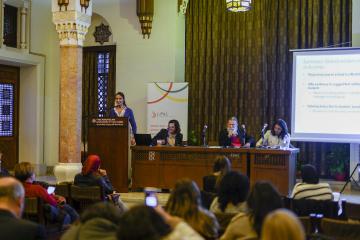
Designing adaptive social assistance during COVID-19: A recap from the Evidence for Egypt Spotlight Webinar

Despite progress in setting up social protections achieved by the Egyptian government over the past years, the global economic shock stemming from the COVID-19 pandemic has challenged Egypt’s economy and directly affected its most vulnerable citizens. According to Egypt’s Central Agency for Public Mobilization and Statistics, 73.5 percent of Egyptian families have reported a decline in income due to the pandemic. This large and widespread shock has pushed more Egyptians into poverty, making it all the more essential to rethink how social assistance systems can be more adaptive.
To address how existing social assistance programs could be enhanced in response to COVID-19 and large external shocks in general, J-PAL Middle East and North Africa (MENA) at the American University in Cairo’s School of Business and UNICEF Egypt held a webinar on October 12, 2020 titled “Social Assistance Response to Large External Shocks in Egypt: What We Can Learn from Randomized Evaluations.” The webinar was the third of a broader Global Evidence for Egypt Spotlight Seminar Series that aims to foster a discussion using rigorous evidence between Egyptian policymakers, development practitioners, and J-PAL affiliated researchers on timely policy priorities in Egypt.
The webinar featured H.E. Nivine El-Kabbag (Minister of Social Solidarity in Egypt), William Parienté, (UC Louvain, J-PAL affiliate), and Noura Selim (Executive Director of the Sawiris Foundation for Social Development).
H.E. El-Kabbag opened the discussion by sharing highlights from the Ministry’s social assistance response strategy that targets vulnerable groups most affected by COVID-19 in Egypt, with a particular focus on women, children, and refugees. Parienté then shared key takeaways from rigorous global evidence on social assistance and insights into their potential application in the Egyptian context. Selim concluded by sharing reflections on and learnings from an impact evaluation of a program to support the ultra-poor in Egypt, conducted in partnership with J-PAL MENA.
The Government of Egypt’s social assistance response to COVID-19
The Ministry of Social Solidarity (MoSS) and the Egyptian government at large designed a multifaceted response to COVID-19 to ensure social assistance reached remote communities and the informal sector. Assistance ranged from offering cash transfers to poor and vulnerable households to providing hygiene kits and food supplies, disinfecting neighborhoods, providing shelters for refugees, protecting victims of gender-based violence, offering emergency support funds to individuals who worked in the crisis-affected tourism sector, and supporting women to repay their loans.
The Ministry expanded its scheme for identifying poor individuals to capture those who fell into poverty during COVID-19, especially the elderly, people with disabilities, and single-parent households. As a result, the MoSS offered cash transfers to 3.6 million households, representing 14.8 million individuals. The Egyptian government also provided informal and casual workers with a 3-month EGP500 (US$31.80) cash transfer through smart cards.
Community workers are critical during the pandemic in raising awareness and delivering accurate information to citizens on hygiene, health, nutrition, and education. As such, the MoSS increased the number of community workers from 2,000 to 9,000 and developed, in collaboration with UNICEF, an interactive platform to communicate with them.
Finally, the MoSS launched an online unified database to coordinate and publish social assistance programs from the government and NGOs.
Lessons for designing more adaptive social assistance programs
Research by J-PAL affiliated researchers on social assistance programs show that design and implementation details matter for their effectiveness. The webinar covered a number of insights into effective design features to make programs more adaptive to COVID-19, which are summarized in the following section.
Complement existing targeting schemes to avoid exclusion of those in need
Traditional approaches that target the longer-term poor using survey data may fall short in identifying affected groups in times of recent external shocks. Evidence from Indonesia and Kenya indicates that these approaches could be complemented with community-based targeting and self-targeting to identify newly vulnerable groups.
Emphasize the beneficiary experience when delivering programs
In some instances, beneficiaries may be unaware of a program’s existence or means of accessing it. Only 2.5 percent of cash transfers beneficiaries in Egypt were aware that further conditions were to be added to continue receiving cash transfers. Evidence from Indonesia indicates that providing program information to beneficiaries can be a cost-effective way to improve their access to services and reduce corruption.
Design conditionalities that allow beneficiaries to flexibly adapt to shocks
Conditioning assistance on certain activities such as school attendance and hospital check-ins may exclude poor households or discourage people from applying to programs during COVID-19, as enforcing these conditions may be unfeasible. Evidence from Morocco suggests that cash transfers with suggested, rather than required, uses have similar effects to conditional cash transfers, and may thus be more cost-effective during the pandemic.
Consider “big-push” assistance policies to support graduation from poverty
Evidence from Ethiopia, Ghana, Honduras, India, Pakistan, and Peru suggests that adapting BRAC’s Graduation Approach, which combines a variety of supports to those living in extreme poverty in one “big push” intervention, may have broad and lasting economic impacts. The Graduation Approach is currently being implemented in Egypt by the Sawiris Foundation for Social Development as the Bab Amal Program. Selim noted that adding elements of social protection and social empowerment to the intervention’s financial inclusion, economic empowerment, and coaching components have been highly effective and unique aspects of the Bab Amal Program.
This webinar on social assistance response to large external shocks in Egypt provided a timely opportunity for government officials, NGOs and academic researchers to engage on how global evidence can be applied in the Egyptian context to inform potential responses to economic and social shocks affecting the most vulnerable during the COVID-19 pandemic.
J-PAL MENA will continue engaging policymakers, development practitioners, and J-PAL affiliates in discussions on priority issues and development challenges in Egypt as part of its Global Evidence for Egypt Spotlight Seminar Series. Follow J-PAL MENA’s accounts on Twitter, Facebook, and LinkedIn to find out about future events and webinars.



